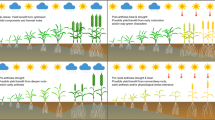Summary
Breeding programs aim at improving crop production either within given macroenvironments (for example rainfed vs. irrigated) or in a wide range of growing conditions. The merit of either strategy depends on the range of testing environments and on the definition of stress environment. When environments with average yields of 3–4 t/ha are defined as ‘stress environments’, selection for stress conditions can be successfully conducted under optimum conditions. However, when the stress environment has a much lower yield potential (0.5–2.0 t/ha), direct selection in the target environment is the most efficient strategy.
A review of data on ‘widely adapted genotypes’ supports this conclusion.
The relative magnitude of heritability in stressed and non-stressed environments is not sufficient to choose the optimum environment for selection, because phenotypic differences can be of opposite sign in different environments.
The role of constitutive characters as analytical tools in breeding for yield stability in stress environments is briefly discussed.
Similar content being viewed by others
References
Acevedo, E. & S. Ceccarelli, 1989. Role of physiologist/Breeder in a Breeding Program for Drought Resistance Conditions. In: Drought Resistance in Cereals-Theory and Practice (in press).
Allen, F.L., R.E. Comstock & D.C. Rasmusson, 1978. Optimal Environments for Yield Testing. Crop Sci. 18: 747–751.
Anderson, J.R., R.W. Herdt & G.M. Scobie, 1985. The Contribution of International Agricultural Research to World Agriculture. Amer. J. Agr. Econ. 67: 1080–1084.
Blum, A., 1985. Breeding crop varieties for stress environments, CRC Critical review in plant sciences 2(3): 199–238.
Bruckner, P.L. & R.C. Frohberg, 1987. Stress tolerance and Adaptation in Spring Wheat. Crop Science 27: 31–36.
Ceccarelli, S., 1987a. Yield potential and drought tolerance of segregating populations of barley in contrasting environments. Euphytica 36: 265–274.
Ceccarelli, S., 1987b. Breeding strategies to improve barley yield and stability in drought prone environments. In: L. Monti & E. Porceddu (Eds) Drought resistance in plants. Physiological and genetic aspects: 333–348.
Ceccarelli, S., 1987c. Tolerance to climatic stresses. Barley Genetics V. Proceed. Fifth Intern. Barley Genetics Symposium, Okayama (6–12 October, 1986), 689–702.
Ceccarelli, S., M.M. Nachit, G.O. Ferrara, M.S. Mekni, M. Tahir, J.A.G. van Leur & J.P. Srivastava, 1987. Breeding Strategies for Improving Cereal Yield and Stability under Drought. In: J.P. Srivastava, E. Porceddu, E. Acevedo & S. Varma (Eds). Drought Tolerance in Winter Cereals. 101–114. John Wiley and Sons. New York.
Ceccarelli, S. & S. Grando, 1989. Efficiency of empirical selection under stress conditions. Genetics and Breeding. (in press).
Cooper, P.J.M., 1984. The potential of improved varieties. ICARDA, Annual Report 1984: 12.
Dalrymple, D.G., 1985. The development and Adoption of High-Yielding Varieties of Wheat and Rice in Developing Countries. Amer. J. Agr. Econ. 67: 1068–1073.
Finlay, K.W. & G.H. Wilkinson, 1963. The analysis of adaptation in a plant breeding programme. Aust. J. Agric. Res. 14: 742–754.
Fischer, R.A. & Maurer, 1978. Drought resistance in spring wheat cultivars. I. Grain yield responses. Aust. J. Agric. Res. 29: 897–912.
Gallais, A., 1984. Use of indirect selection in plant breeding. In: W. Lange, A.C. Zeven & N.G. Hogenboom (Eds) Efficiency in plant breeding. Proceed. 10th Congress of Eucarpia. Pudoc, Wageningen, p. 45–60.
Grando, S., A. Grillo, S. Ceccarelli & E. Acevedo, 1988. Diversity for seedling root characters in barley (in preparation).
Hadjichristodoulou, A., 1985. The stability of the number of tillers of barley varieties and its relation with consistency of performance under semi-arid conditions. Euphytica 34: 641–649.
Loffler, C.M., M.T. Salaberry & J.C. Maggio, 1986. Stability and genetic improvement of maize yields in Argentina. Euphytica 35: 449–458.
Osmanzai, M., S. Rajaram & E.B. Knapp, 1987. Breeding for Moisture-stressed Areas. In: J.P. Srivastava, E. Porceddu, E. Acevedo and S. Varma (Eds) Drought Tolerance in Winter Cereals. 151–161. John Wiley and Sons. New York.
Rajaram, S., B. Skovmand & B.C. Curtis, 1984. Philosophy and methodology of an international wheat breeding program. In: J.P. Gustafson (Ed.) Gene manipulation in Plant Improvement: 33–60.
Ramage, R.T., 1987. Form and Function in barley breeding. Proceed. Fifth Int. Barley Genet. Symp., Okayama, Japan, 6–12 Oct., 1986 (in press).
Richards, R.A. & J.B. Passioura, 1981a. Seminal Root Morphology and Water Use of Wheat. I. Environmental Effects. Crop Sci. 21: 249–252.
Richards, R.A. & J.B. Passioura, 1981b. Seminal Root Morphology and Water Use of Wheat. II. Genetic Variation. Crop Sci. 21: 253–255.
Robertson, B.M., J.G. Waines & B.S. Gill, 1979. Genetic Variability for Seedling Root Numbers in Wild and Domesticated Wheats. Crop Sci. 19: 843–847.
Shannon, M.C. & L.E. Francois, 1978. Salt tolerance of three muskmelon cultivars. J. Am. Soc. Hort. Sci. 103: 127.
Sojka, R.E., 1985. Field evaluation of drought response in small-grain cereals. In: G.E. Russell (Ed) Progress in Plant Breeding-1. 165–191, Butterworths.
Sojka, R.E., L.H. Stolzy & R.A. Fischer, 1981. Seasonal drought response of selected wheats cultivars. Agronomy Journal 73: 838–845.
Author information
Authors and Affiliations
Rights and permissions
About this article
Cite this article
Ceccarelli, S. Wide adaptation: How wide?. Euphytica 40, 197–205 (1989). https://doi.org/10.1007/BF00024512
Received:
Accepted:
Issue Date:
DOI: https://doi.org/10.1007/BF00024512




